Lancer
GSR Evolution VII
 Evo
V, good. Evo VI, better. Tommi Makinen, welcome. Anyway, they were just
small evolutions from the Evo IV because the chassis and powertrain
were
basically unchanged. As the Lancer sedan was renewed in mid-2000, the
new
Evolution VII also enjoys a new chassis. In addition to a new active
differential,
Evo's fans have more things to talk about than ever. Evo
V, good. Evo VI, better. Tommi Makinen, welcome. Anyway, they were just
small evolutions from the Evo IV because the chassis and powertrain
were
basically unchanged. As the Lancer sedan was renewed in mid-2000, the
new
Evolution VII also enjoys a new chassis. In addition to a new active
differential,
Evo's fans have more things to talk about than ever.
Let us start from
the chassis
first. The regular Lancer Cedia is already far more rigid than its
predecessor,
but the Evolution strengthened it further by adding some 200 spot welds
to suspension attachment, sills, pillars, floorpan etc. - the result is
50% higher torsional stiffness than the outgoing Evo VI !
For crash
protection, refinement
and space reasons the Lancer sedan is also considerably heavier than
before,
just like the new Impreza. However, unlike Subaru, Mitsubishi made
extra
effort to cut fat from Evo VII, including using aluminium bonnet and
front
fenders, magnesium cam cover (these improve weight distribution as
well),
thinner roof panel and glass. Even the Recaro seats are lighter. They
also
reviewed the rear wing and decided to discard its adjustable function.
All these works result in just 40 kg increment over Evo VI, which is
undoubtedly
very good considering the car is 105 mm longer, 45 mm wider and have a
wheelbase stretched by 115 mm.
The powerplant
remains to
be the familiar 2.0-litre turbocharged four named 4G63. Believe or not,
it has been serving Lancer GSR since the first generation ! this latest
version is believed to be the last evolution of the engine and it will
be replaced by an all-new GDI unit in Evo VIII. As it reaches the end
of
life span, not many things can be improved. In particular, it is still
lack of variable valve timing or variable intake. Here is the list of
minor
improvement: hollow camshafts, smaller turbo nozzle for better
mid-range
response, variable back-pressure exhaust for improved noise and lower
back
pressure, higher flow intercooler with 1 more water spray injector and
at last a bigger oil-cooler. These small tweaks add 1 kgm (7 lbft) of
peak
torque while - officially speaking - peak power remains at the domestic
voluntary limit of 280 hp. I believe the actual figure has already
exceeded
300 hp.
The old Evo VI
did 0-60 in
4.4 sec and 0-100 in 11.2 sec. The new car is 40 kg heavier but deliver
slightly more torque, so in terms of straight line acceleration it is
more
or less the same as before. However, in terms of cornering the new car
is obviously quicker, thanks to improved chassis and 4-wheel drive
system.
It is always more resistant to understeer. If we define the outgoing
car's
cornering limit as 100%, then the new one will be 108%. Someone lapped
a new GSR in Japan's Tsukuba race track in 1 min 6.67 sec, eclipsing
Evo
VI's 1 min 6.71. Yet this is just in a smooth and familiar racing
circuit.
In real world - less predictable public roads or poorer surfaces - the
difference will be inevitably much bigger.
Now let us talk
about the
most interesting part - the drivetrain. While transmission is virtually
the same 5-speeder (sorry, the rumoured 6-speeder did not come true,
giving
Impreza STi a clear advantage here), the center differential is new.
All
previous Lancer Evo employed a simple viscous-coupling unit as center
LSD,
whose disadvantages are passive and a fair amount of delay (see
Technical
School). Calling ACD (Active Center Differential), the new unit is a
multi-plate
clutch whose degree of engagement is controlled by computer via
hydraulic
according to needs. New concept ? no, it was pioneered by Porsche 959
and
is now using by Audi TT, Volkswagen Golf 4motion etc. What differs it
from
other similar systems is that it cooperates with the existing AYC
(Active
Yaw Control) and, I believe, its software is the best developed among
all.
Undoubtedly, Mitsubishi's experience and requirements in World Rally
Championship
must help a lot the tuning of the system. By the way, rally cars such
as
Focus WRC also use active center differentials.
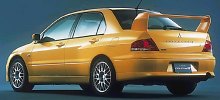 So
what is the advantage of active differential ? firstly, using
multi-plate
clutch instead of viscous liquid speeds up response by 3 times.
Secondly,
the torque split between front and rear axle can be varied many times
during
cornering to maximize grip and steering response. Normally the torque
split
is 50:50. When entering a corner, ACD will tend to distribute equal
amount
of torque to both axle by locking up the clutches in order to maximize
grip and induce a bit understeer - both of them are vital to stabilize
the car. In mid-corner, ACD will tend to disengage the clutches thus
allow
more speed difference between front and rear wheels, which is vital to
cornering agility. In the exit phase ACD will lock up again to equalize
pulling force on all wheels, hence maximize traction to pull the car
out
of corner. So
what is the advantage of active differential ? firstly, using
multi-plate
clutch instead of viscous liquid speeds up response by 3 times.
Secondly,
the torque split between front and rear axle can be varied many times
during
cornering to maximize grip and steering response. Normally the torque
split
is 50:50. When entering a corner, ACD will tend to distribute equal
amount
of torque to both axle by locking up the clutches in order to maximize
grip and induce a bit understeer - both of them are vital to stabilize
the car. In mid-corner, ACD will tend to disengage the clutches thus
allow
more speed difference between front and rear wheels, which is vital to
cornering agility. In the exit phase ACD will lock up again to equalize
pulling force on all wheels, hence maximize traction to pull the car
out
of corner.
Another advantage
of ACD
is that it is adaptive to road conditions. Choose "Tarmac" mode and it
will allow more clutch slippage, hence torque transmit freely from one
end to another. "Gravel" mode tends to limit the difference between
front
and rear torque split so to minimize tyre slip. "Snow" mode nearly lock
up all wheels to prevent from any wheel spin.
The last
advantage is that
it cooperates with AYC. Remember the active yaw control ? it has been
adopted
since Evo IV and is renowned for killing the understeer character of
the
car. It is actually a small multi-plate clutch incorporated inside rear
differential. When the clutches engage, more torque will be sent to the
opposite wheel. In mid-corner, AYC directs more torque to outside rear
wheel to reduce understeer or even induce oversteer as desired. Exit
corner,
it transmits more torque to inside rear wheel to induce understeer for
stability. The AYC in new Evo is unchanged, but it shares the computer
and sensors (steering angle, g-force, yaw, wheel speed etc.) with ACD
and
communicate with each other to optimise the result. Think about it, ACD
adjusts torque split between front and rear while AYC takes care of
left
and right (rear wheels), so they can virtually control the torque
transmitted
to any individual wheel as desired. As long as the software is right,
this
is the ultimate drivetrain engineers dreamed for decades !
On The Road
You will never
appreciate
its styling, but honestly speaking I think the (relatively) leaner look
of the new car is far better than the horrible He-man style of the old
one (I don't like He-man, by the way), although few journalists agree
with
me. Anyway, if you really care about styling, you must wait for the
forthcoming
Focus Cosworth.
In contrast, all
people will
agree that the new cockpit is a big improvement. Apart from more head
room
and rear passenger leg room, the dashboard also looks smarter and made
of higher quality plastic. Thanks God, the fake wood found in regular
Lancer
Cedia is no longer here. Facing the superb Recaro seats are chromed-rim
gauges and a window showing the manual selection of ACD - "Tarmac",
"Gravel"
and "Snow". Interesting enough ?
Twist the key and
you'll
notice the engine is silencer - thanks to variable exhaust and better
noise
insulation of the stronger body shell. Simultaneously, you'll find
throttle
response is sharper than ever once the turbo is operating. Among all
turbo
machines, you might need a 911 Turbo to beat its throttle response. For
best results from the engine you still need 3,000 rpm, but the torque
curve
is obviously flatter - not only comes earlier but also drops later.
Power
band is strongest between 2,750 and 5,500 rpm. Turbo lag has been
reduced
a lot, although a single big turbo indicates that it is not in the
league
of Audi RS4, that miracle turbo machine.
Very quick, no
doubt, but
anyone having experienced the Evo V upwards won't be scared. Instead,
they
will be surprised by the new-found refinement. The strong chassis and
additional
suspension travel (15mm front and 10mm rear) result in less thump and
bang
on rough surfaces. The steering column transmits less vibration. Noise
level is well down. However, all these are relative. Compare with other
sports sedans - new Impreza STi inclusive - it still rides very hard
thus
is not a good companion for long journey.
Although we would
have preferred
one more ratio, transmission has a decent shift quality while it
matches
the power band very well. It is not as slick as Subaru STi's 6-speeder,
but with shorter throw, true decisive and meaty feel. Autocar's test
editor
Stephen Sutcliffe said qualitatively speaking it is more satisfying
than
Subaru's six-speeder but both EVO and a Japanese journalist said it
could
be sticky in a hurry. However, there is no room for argument that the
braking
is first class. The Brembo brakes are not only powerful but pedal feel
is also superb.
However, the
strongest area
of the new Evo is cornering ability. Apart from TVR Tuscan we have
never
seen a car with a steering so direct - just 2.0 turns from lock to lock
! in addition to active yaw control, steering response is astonishing.
At first you might think it is too nervous, but getting use to it
you'll
discover it is extremely precise and well weighted while that
directness
allows you to attack corner with the least hands movement yet full
confidence.
The result is, we have never seen a car turn-in so enthusiastically and
corner so quickly. The power of ACD and AYC is really astonishing. They
give the car bags of grip yet virtually no understeer. Best of all, the
computer cleverness does not devoid of driver involvement. You can
still
adjust driving angle and line by cooperating throttle and steering and
even plays power slide.
Undoubtedly,
Mitsubishi has
succeeded developing the ultimate driving machine in the world. It is
the
quickest A-to-B car ever made. Best of all, it remains to be a bargain.
Subaru Impreza STi is thoroughly knocked out.
Click here for Evo
VII versus STi
|
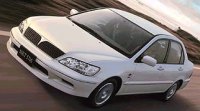 The
seventh generation Lancer gains an additional name "Cedia" which is the
combination of "Century" and "Diamond". Sounds a little bit prestige,
at
least Mitsubishi is thinking so. This implies the new Lancer is
designed
to be more luxurious and conservative but not as sporty as its
predecessor.
The
seventh generation Lancer gains an additional name "Cedia" which is the
combination of "Century" and "Diamond". Sounds a little bit prestige,
at
least Mitsubishi is thinking so. This implies the new Lancer is
designed
to be more luxurious and conservative but not as sporty as its
predecessor.
 Lancer
Ralliart is produced exclusively for the US market. It targets at the
"pocket
rocket" segment currently consists of Ford SVT Focus, Honda Civic Si,
Dodge
Neon SRT-4, Mazdaspeed Protege Turbo and Mini Cooper S. Based on the
front-drive
Lancer sedan chassis, Mitsubishi reinforced the chassis with front
tower
strut, stiffened springs and dampers, retuned power steering and
adopted
16-inch 205/50 tires. According to testers, handling and ride is
surprisingly
good, easily being the best front-drive Mitsubishi. Crisp turn-in,
stable
cornering and compliant ride make it a satisfying driver’s car.
Lancer
Ralliart is produced exclusively for the US market. It targets at the
"pocket
rocket" segment currently consists of Ford SVT Focus, Honda Civic Si,
Dodge
Neon SRT-4, Mazdaspeed Protege Turbo and Mini Cooper S. Based on the
front-drive
Lancer sedan chassis, Mitsubishi reinforced the chassis with front
tower
strut, stiffened springs and dampers, retuned power steering and
adopted
16-inch 205/50 tires. According to testers, handling and ride is
surprisingly
good, easily being the best front-drive Mitsubishi. Crisp turn-in,
stable
cornering and compliant ride make it a satisfying driver’s car.
 Evo
V, good. Evo VI, better. Tommi Makinen, welcome. Anyway, they were just
small evolutions from the Evo IV because the chassis and powertrain
were
basically unchanged. As the Lancer sedan was renewed in mid-2000, the
new
Evolution VII also enjoys a new chassis. In addition to a new active
differential,
Evo's fans have more things to talk about than ever.
Evo
V, good. Evo VI, better. Tommi Makinen, welcome. Anyway, they were just
small evolutions from the Evo IV because the chassis and powertrain
were
basically unchanged. As the Lancer sedan was renewed in mid-2000, the
new
Evolution VII also enjoys a new chassis. In addition to a new active
differential,
Evo's fans have more things to talk about than ever.
 So
what is the advantage of active differential ? firstly, using
multi-plate
clutch instead of viscous liquid speeds up response by 3 times.
Secondly,
the torque split between front and rear axle can be varied many times
during
cornering to maximize grip and steering response. Normally the torque
split
is 50:50. When entering a corner, ACD will tend to distribute equal
amount
of torque to both axle by locking up the clutches in order to maximize
grip and induce a bit understeer - both of them are vital to stabilize
the car. In mid-corner, ACD will tend to disengage the clutches thus
allow
more speed difference between front and rear wheels, which is vital to
cornering agility. In the exit phase ACD will lock up again to equalize
pulling force on all wheels, hence maximize traction to pull the car
out
of corner.
So
what is the advantage of active differential ? firstly, using
multi-plate
clutch instead of viscous liquid speeds up response by 3 times.
Secondly,
the torque split between front and rear axle can be varied many times
during
cornering to maximize grip and steering response. Normally the torque
split
is 50:50. When entering a corner, ACD will tend to distribute equal
amount
of torque to both axle by locking up the clutches in order to maximize
grip and induce a bit understeer - both of them are vital to stabilize
the car. In mid-corner, ACD will tend to disengage the clutches thus
allow
more speed difference between front and rear wheels, which is vital to
cornering agility. In the exit phase ACD will lock up again to equalize
pulling force on all wheels, hence maximize traction to pull the car
out
of corner. 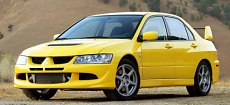 Finally,
Evolution VIII is understood to be the last evolution of the hot
Lancer.
From 2005, its status as a WRC rally car will be substituted by the
smaller
Mirage / Colt hatchback. Perhaps the Lancer has got too big and heavy
during
all those years.
Finally,
Evolution VIII is understood to be the last evolution of the hot
Lancer.
From 2005, its status as a WRC rally car will be substituted by the
smaller
Mirage / Colt hatchback. Perhaps the Lancer has got too big and heavy
during
all those years.
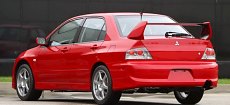 10
more kg and 7 more pound-feet would have meant unchanged performance,
but
here is the real breakthrough: the Evo VIII employs a new 6-speed
manual
gearbox, replacing the long-serving 5-speeder. This is the company’s
first
all-new gearbox in a decade. Its shifts as quick and precise as the old
5-speed unit, with the benefit of closer ratio and therefore higher
performance.
According to official figures, 0-60mph now cuts to 4.6 seconds. The
performance
gain is marginal, but tell me what else at this price can offer
sub-5-second
0-60 and sit 4 people? the Japanese rally cars are still unmatched by
European
challengers.
10
more kg and 7 more pound-feet would have meant unchanged performance,
but
here is the real breakthrough: the Evo VIII employs a new 6-speed
manual
gearbox, replacing the long-serving 5-speeder. This is the company’s
first
all-new gearbox in a decade. Its shifts as quick and precise as the old
5-speed unit, with the benefit of closer ratio and therefore higher
performance.
According to official figures, 0-60mph now cuts to 4.6 seconds. The
performance
gain is marginal, but tell me what else at this price can offer
sub-5-second
0-60 and sit 4 people? the Japanese rally cars are still unmatched by
European
challengers. 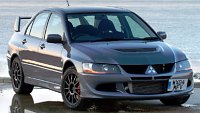 This
is another evolution of the hot Lancer. As the modification is small
compare
with previous evolutions, this time the Evolution count remains at
VIII,
but it is followed by a label "MR" which stands for "Mitsubishi Racing"
officially, or in my understanding, "Minor Revision".
This
is another evolution of the hot Lancer. As the modification is small
compare
with previous evolutions, this time the Evolution count remains at
VIII,
but it is followed by a label "MR" which stands for "Mitsubishi Racing"
officially, or in my understanding, "Minor Revision".
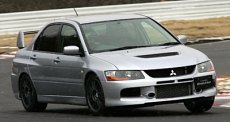 The
9th generation changes little from its predecessor, Evo VIII MR.
Basically, the chassis and the ACD / Super AYC drivetrain are
unchanged. Improvement concentrates on the engine and minor tweaks to
aerodynamic.
The
9th generation changes little from its predecessor, Evo VIII MR.
Basically, the chassis and the ACD / Super AYC drivetrain are
unchanged. Improvement concentrates on the engine and minor tweaks to
aerodynamic.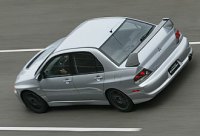 Since
chief designer Olivier Boulay left Mitsubishi, the Evo IX's exterior
design has gone back to function-driven. The organic nose of the Evo
VIII gives way to a conventional nose with larger rectangular
intakes. Under the car, there are some aerodynamic tweaks to improve
underbody air flow. At the tail, the rear spoiler is now of made of
hollow carbon fiber.
Since
chief designer Olivier Boulay left Mitsubishi, the Evo IX's exterior
design has gone back to function-driven. The organic nose of the Evo
VIII gives way to a conventional nose with larger rectangular
intakes. Under the car, there are some aerodynamic tweaks to improve
underbody air flow. At the tail, the rear spoiler is now of made of
hollow carbon fiber.